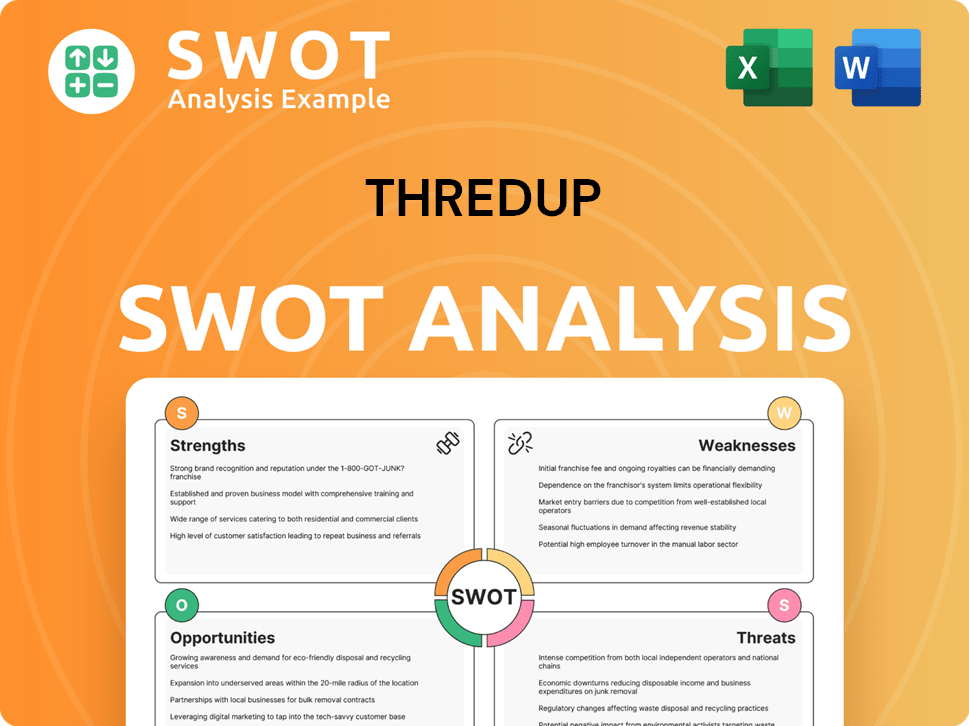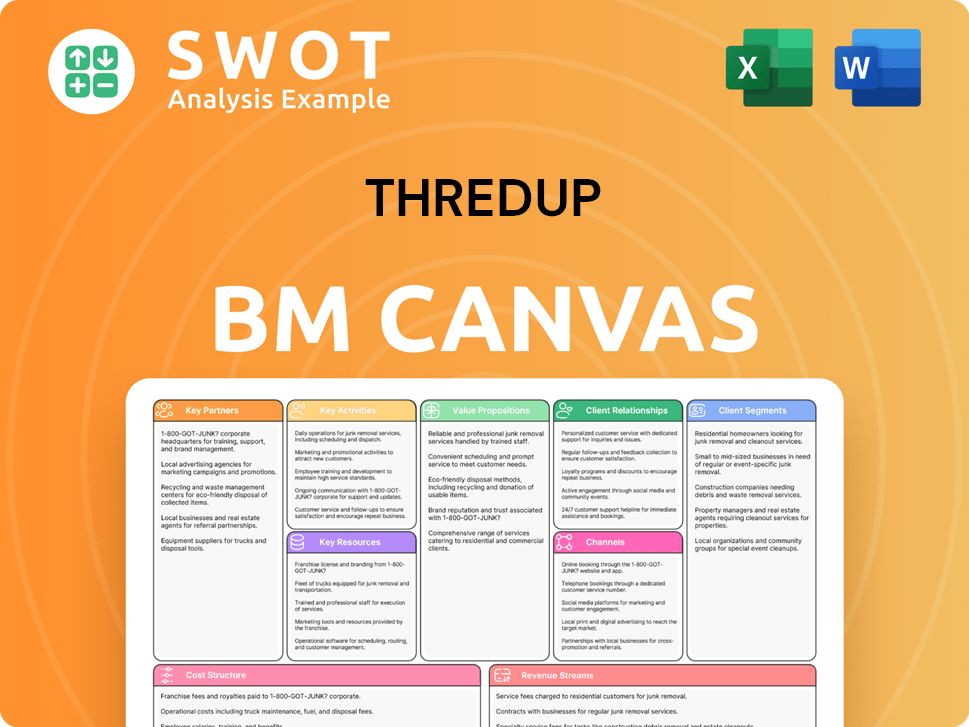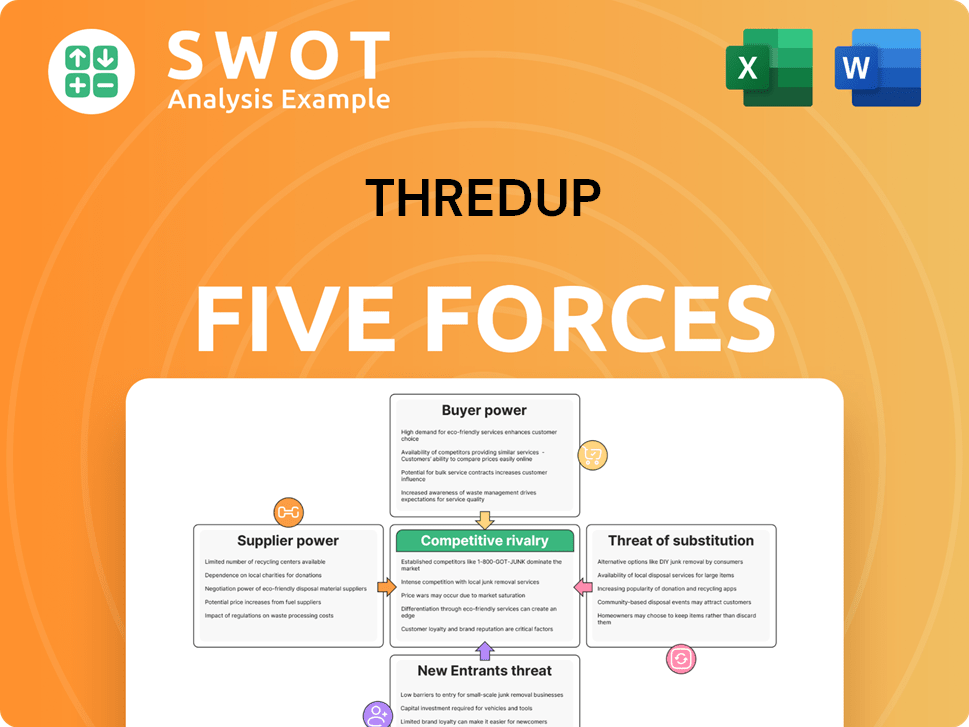ThredUp Bundle
How Does ThredUp Company Work?
Are you curious about the inner workings of the online consignment giant, ThredUp? This innovative company has revolutionized the ThredUp SWOT Analysis, offering a sustainable solution for fashion enthusiasts. As the secondhand apparel market continues to boom, understanding How ThredUp works is essential for anyone looking to invest, sell, or simply shop smarter.

ThredUp, a leading online consignment store, has created a seamless experience for both buyers and sellers in the clothing resale market. Its success lies in its ability to provide a convenient platform for decluttering and discovering unique fashion finds. This exploration will uncover the ThredUp company's operational strategies, from its ThredUp selling process to its impact on the circular economy, giving you a comprehensive ThredUp review.
What Are the Key Operations Driving ThredUp’s Success?
The core of the ThredUp company revolves around simplifying the buying and selling of secondhand clothing. This approach creates value through convenience, affordability, and a focus on sustainability. The platform caters to a wide audience, including eco-conscious consumers, budget shoppers, and individuals looking to declutter their closets without the typical hassles of traditional consignment or peer-to-peer selling.
The main product offered is a curated inventory of pre-owned fashion items, all accessible via its online platform. This focus on a streamlined process, from the initial clean-out kit to the final purchase, is what sets How ThredUp works apart in the resale marketplace.
The operational flow begins when sellers request a 'Clean Out Kit' from ThredUp. After filling it with unwanted clothing, shoes, and accessories, sellers ship the kit back to ThredUp. The company then meticulously inspects, photographs, lists, and prices the accepted items. This rigorous quality control and professional presentation differentiate ThredUp from many peer-to-peer platforms. ThredUp handles all aspects of the transaction, including payment processing, shipping, and customer service, providing a seamless experience for both buyers and sellers. This comprehensive service removes significant friction points associated with traditional secondhand markets, making it uniquely effective.
Sellers order a Clean Out Kit from ThredUp. They fill it with unwanted clothing, shoes, and accessories. The kit is then shipped back to ThredUp for processing.
ThredUp inspects, photographs, lists, and prices accepted items. This ensures quality control and professional presentation. The company handles all transaction aspects, including shipping.
ThredUp provides a seamless experience for both buyers and sellers. This includes payment processing and customer service. The platform simplifies the secondhand market process.
The platform offers access to affordable fashion and convenience in selling unwanted items. It also promotes the positive environmental impact of extending clothing lifecycles.
ThredUp's supply chain is robust, featuring processing centers where items are received, sorted, and prepared for sale. The company uses proprietary technology for inventory management, pricing algorithms, and personalized recommendations to enhance the customer shopping experience. Partnerships with brands and retailers through its 'Resale-as-a-Service' (RaaS) platform further expand its sourcing capabilities and solidify its position in the recommerce ecosystem. This operational efficiency and commitment to a high-quality, curated inventory translate into customer benefits such as access to a vast selection of affordable fashion, convenience in selling unwanted items, and the positive environmental impact of extending the life cycle of clothing. For more insights into the strategies that propelled the platform, explore the Growth Strategy of ThredUp.
The company's operations are centered on a streamlined process for both buyers and sellers. They use technology to manage inventory and personalize the shopping experience. Partnerships play a key role in expanding sourcing and market presence.
- Clean Out Kits: Sellers receive kits to send in their items.
- Quality Control: Items undergo inspection, photography, and pricing.
- Technology: Inventory management and pricing algorithms are used.
- Customer Service: Comprehensive support for buyers and sellers.
ThredUp SWOT Analysis
- Complete SWOT Breakdown
- Fully Customizable
- Editable in Excel & Word
- Professional Formatting
- Investor-Ready Format

How Does ThredUp Make Money?
The ThredUp company generates revenue primarily through the sale of secondhand clothing, shoes, and accessories. Operating on a consignment model, the company takes a commission on each sale. This commission structure is a key element of how ThredUp works, influencing both its profitability and its appeal to sellers.
The commission rates vary depending on the selling price of the item. This tiered system ensures that ThredUp can profit from a wide range of items, from lower-priced everyday wear to higher-value designer pieces. This approach helps the company to maintain a diverse inventory and attract a broad customer base.
Beyond direct sales, ThredUp has expanded its monetization strategies. The 'Resale-as-a-Service' (RaaS) platform allows brands to integrate resale directly into their operations. This strategic initiative diversifies revenue and strengthens partnerships within the fashion industry. The company also generates revenue through shipping fees and promotional activities.
Understanding the commission structure is crucial for anyone looking to sell on ThredUp. Payout percentages vary significantly based on the item's selling price, directly impacting the seller's earnings. The ThredUp selling process is designed to be transparent, but it's important to understand the specifics to maximize your returns.
- For items priced under $5.00, sellers typically receive between 3% and 15% of the sale price.
- As the price increases, the payout percentage also increases.
- Items priced over $200.00 can result in payouts of 60% to 80% to the seller.
- This tiered system incentivizes the sale of higher-value items while still allowing ThredUp to profit from lower-priced goods.
The RaaS platform represents a significant shift in ThredUp's business model, enabling partnerships with established brands and retailers. This expansion allows ThredUp to tap into new revenue streams and solidify its position in the clothing resale market. This strategy is part of a broader trend toward circular fashion, as discussed in Marketing Strategy of ThredUp.
- RaaS enables brands to offer resale services directly to their customers, leveraging ThredUp's technology and logistics.
- This approach helps brands to engage with environmentally conscious consumers and extend the lifecycle of their products.
- While specific revenue figures for RaaS are not always detailed in financial reports, it is a key strategic initiative.
- Partnerships within the fashion industry are crucial for driving growth and expanding market reach.
ThredUp PESTLE Analysis
- Covers All 6 PESTLE Categories
- No Research Needed – Save Hours of Work
- Built by Experts, Trusted by Consultants
- Instant Download, Ready to Use
- 100% Editable, Fully Customizable

Which Strategic Decisions Have Shaped ThredUp’s Business Model?
The journey of the ThredUp company has been marked by significant milestones, shaping its operations and financial trajectory. A key strategic move was the consistent investment in its proprietary technology and logistics infrastructure, enabling the efficient processing of millions of unique items. The launch and expansion of its 'Clean Out Kit' streamlined the selling process for consumers, addressing a major hurdle in the secondhand market.
A pivotal moment was the company's public listing in 2021, which provided capital for expansion and solidified its market presence. The company has strategically responded to market challenges, such as fluctuations in consumer spending and the complexities of managing a vast, ever-changing inventory. Its adaptation includes refining pricing algorithms and optimizing operational workflows to maintain profitability.
A key competitive advantage for ThredUp is its strong brand recognition and trust within the recommerce space. Consumers are drawn to its curated selection and the convenience of its service, which differentiates it from less structured peer-to-peer platforms. The company continues to adapt to new trends by emphasizing sustainability and leveraging data to personalize the shopping experience, ensuring its continued relevance in a dynamic industry.
The introduction of the 'Clean Out Kit' simplified the ThredUp selling process and attracted more sellers. The 2021 IPO was a significant financial milestone, providing capital for expansion. Continuous investment in technology and logistics has enabled efficient processing of a large volume of items.
Refining pricing algorithms and optimizing operational workflows helped maintain profitability. Expanding the 'Resale-as-a-Service' (RaaS) offering allowed traditional retailers to enter the secondhand market. The company focuses on sustainability and data-driven personalization to stay relevant in the industry.
Strong brand recognition and consumer trust in the resale marketplace are key. Technology leadership in authentication and inventory management provides an advantage. The curated selection and convenience of service differentiate it from peer-to-peer platforms.
In 2024, ThredUp reported gross merchandise value (GMV) of approximately $330 million. Revenue for the year was around $320 million. The company continues to focus on operational efficiency to improve profitability, with adjusted EBITDA improving over the year.
The ability to handle a diverse, single-item inventory at scale is a testament to its operational sophistication. ThredUp's technology leadership is particularly evident in authentication and inventory management, which provides a significant edge. The company's expanding 'Resale-as-a-Service' (RaaS) offering allows traditional retailers to enter the secondhand market with ThredUp's expertise, creating a powerful ecosystem effect.
- Proprietary technology for efficient processing.
- Advanced inventory management systems.
- RaaS partnerships for market expansion.
- Data-driven personalization for customer experience.
ThredUp Business Model Canvas
- Complete 9-Block Business Model Canvas
- Effortlessly Communicate Your Business Strategy
- Investor-Ready BMC Format
- 100% Editable and Customizable
- Clear and Structured Layout

How Is ThredUp Positioning Itself for Continued Success?
The ThredUp company holds a strong position in the rapidly expanding secondhand apparel market. It competes with other online resale platforms, traditional consignment stores, and peer-to-peer marketplaces. As one of the largest players in online resale, ThredUp has built strong customer loyalty through its focus on convenience and curated inventory. Its global reach allows it to serve a wide customer base, although its primary market remains North America.
Despite its market position, ThredUp faces several risks. Economic downturns can impact consumer spending on discretionary items like clothing, affecting both buying and selling activity. Increased competition from new entrants, particularly those leveraging social media or niche markets, could also pose a threat. Logistical challenges and managing quality control at scale present ongoing operational risks. Changing consumer preferences, such as a shift away from fast fashion, could also influence the supply and demand dynamics on its platform.
ThredUp is a major player in the online resale market. It competes with platforms like Poshmark and traditional consignment shops. Its focus on convenience and curated inventory has helped it gain customer loyalty.
Economic downturns can affect consumer spending on clothing. Increased competition and logistical challenges are also risks. Changing consumer preferences, like the move away from fast fashion, can impact the platform.
ThredUp is focusing on expanding its RaaS platform and forming partnerships. It aims to capitalize on the growing demand for sustainable fashion. The company plans to innovate and broaden its reach in the recommerce market.
The company is enhancing its technological capabilities to improve the customer experience. It's also deepening its integration within the fashion ecosystem. Leadership emphasizes the long-term potential of the recommerce market.
Looking ahead, ThredUp's strategy includes expanding its RaaS platform, forming partnerships, and improving its technology. The company is aiming to take advantage of the growing interest in sustainable fashion and circular business models. Leadership is optimistic about the long-term potential of the recommerce market. To learn more about ThredUp's strategic direction, you can read about the Growth Strategy of ThredUp.
ThredUp is a leading player in the online consignment and resale marketplace, facing both opportunities and challenges. The company's focus on convenience and curated inventory has fostered strong customer loyalty. Strategic initiatives are focused on expanding its RaaS platform and enhancing its technological capabilities.
- Growing market for clothing resale.
- Competition from other online consignment platforms.
- Focus on sustainable fashion and circular business models.
- Strategic investments in technology and partnerships.
ThredUp Porter's Five Forces Analysis
- Covers All 5 Competitive Forces in Detail
- Structured for Consultants, Students, and Founders
- 100% Editable in Microsoft Word & Excel
- Instant Digital Download – Use Immediately
- Compatible with Mac & PC – Fully Unlocked

Related Blogs
- What are Mission Vision & Core Values of ThredUp Company?
- What is Competitive Landscape of ThredUp Company?
- What is Growth Strategy and Future Prospects of ThredUp Company?
- What is Sales and Marketing Strategy of ThredUp Company?
- What is Brief History of ThredUp Company?
- Who Owns ThredUp Company?
- What is Customer Demographics and Target Market of ThredUp Company?
Disclaimer
All information, articles, and product details provided on this website are for general informational and educational purposes only. We do not claim any ownership over, nor do we intend to infringe upon, any trademarks, copyrights, logos, brand names, or other intellectual property mentioned or depicted on this site. Such intellectual property remains the property of its respective owners, and any references here are made solely for identification or informational purposes, without implying any affiliation, endorsement, or partnership.
We make no representations or warranties, express or implied, regarding the accuracy, completeness, or suitability of any content or products presented. Nothing on this website should be construed as legal, tax, investment, financial, medical, or other professional advice. In addition, no part of this site—including articles or product references—constitutes a solicitation, recommendation, endorsement, advertisement, or offer to buy or sell any securities, franchises, or other financial instruments, particularly in jurisdictions where such activity would be unlawful.
All content is of a general nature and may not address the specific circumstances of any individual or entity. It is not a substitute for professional advice or services. Any actions you take based on the information provided here are strictly at your own risk. You accept full responsibility for any decisions or outcomes arising from your use of this website and agree to release us from any liability in connection with your use of, or reliance upon, the content or products found herein.